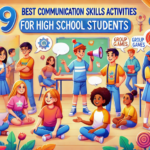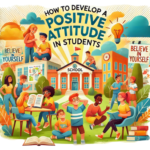High school is a pivotal period for students as they develop critical thinking, problem-solving, and collaboration skills that will prepare them for the future. Educational activities in the classroom provide an opportunity for students to engage with learning in a more dynamic way, going beyond traditional lectures and textbooks. These activities promote creativity, boost engagement, and foster an environment of active learning.
Why Are Educational Activities Important in High School?
Educational activities are essential for high school students as they encourage active participation, help solidify knowledge, and make learning enjoyable. Activities such as debates, group projects, and hands-on experiments engage students in practical applications of theoretical knowledge. These activities also promote teamwork, leadership, and communication skills, which are critical for their personal and academic development. By integrating educational activities into the classroom, teachers can better capture students’ interest and cater to different learning styles.
You may also like: 9 Best Communication Skills Activities for High School Students
Top 10 Educational Activities for High School Students in Classroom
1. Debate and Role-Playing Fusion
Activity: Historical Debate Simulation
- Students are assigned different historical figures or perspectives on a specific event (e.g., World War II). They must research and debate based on the roles they play, combining critical thinking with public speaking and experiential learning.
- Skills Developed: Critical thinking, public speaking, historical understanding, and respectful disagreement.
2. Group Research with Case Studies
Activity: Collaborative Case Study Project
- Small groups of students are given real-world scenarios or case studies related to STEM, history, or social issues. Each group conducts research and presents their findings, discussing potential solutions to the problem presented.
- Skills Developed: Collaboration, research, problem-solving, and critical analysis.
3. STEM Challenge with Mock Trial
Activity: Scientific Mock Trial
- Students investigate a science-related case (e.g., environmental damage, technology ethics) and participate in a mock trial. They take on roles like scientists, lawyers, and witnesses to argue the case using scientific evidence.
- Skills Developed: Analytical thinking, STEM integration, public speaking, and reasoning.
4. Peer Teaching with Interactive Games
Activity: Kahoot Quiz Challenge with Peer Instructors
- Students create their own quiz questions on a specific topic (e.g., literature, history) and take turns leading a Kahoot session, explaining answers after each round. This combines peer teaching with interactive quizzes.
- Skills Developed: Leadership, subject mastery, engagement, and quick thinking.
5. Creative Writing and Art
Activity: Creative Writing Illustrated
- Students write a short story or poem and then create an accompanying visual art piece to represent the themes or emotions of their work. This could be displayed in an “Art and Writing Showcase” in the classroom.
- Skills Developed: Imagination, creative expression, and analytical writing.
6. Presentation Day with Personal Reflection
Activity: Reflection-Based Presentations
- After completing a project, students present their work to the class and include a personal reflection on what they learned, the challenges faced, and how their perspectives evolved during the process.
- Skills Developed: Public speaking, self-awareness, and critical thinking.
7. Role-Playing with Think-Pair-Share
Activity: Ethical Dilemma Role-Playing
- Students are presented with a complex ethical issue (e.g., climate change policy, medical ethics). They work in pairs to discuss potential solutions, then role-play different perspectives to the class.
- Skills Developed: Ethical reasoning, collaborative thinking, and public speaking.
8. Sports-Inspired Debate
Activity: Sportsmanship Debate
- Using the concept of fair play in sports and games, students debate real-world scenarios related to sportsmanship and ethics. This allows them to engage in respectful disagreement while connecting academic and extracurricular interests.
- Skills Developed: Critical thinking, ethics, and respectful communication.
9. Four Corners with Charades
Activity: Four Corners Charades
- The classroom is divided into four corners, each representing a different answer to a question posed by the teacher. After students choose a corner, one representative from each group plays charades to act out their group’s reasoning. The other groups try to guess the reasoning based on the charades.
- Skills Developed: Decision-making, creativity, and collaboration.
10. Chain Spelling with Brainstorming
Activity: Collaborative Chain Brainstorming
- Students form teams to brainstorm solutions to a classroom problem or a creative prompt. Each team member must add to the previous idea, building a “chain” of solutions. Afterward, teams spell out a key word related to their topic in a chain-spelling format.
- Skills Developed: Teamwork, creativity, and critical thinking.
Benefits of Classroom-Based Educational Activities
- Enhanced Engagement: Active learning strategies like debates, games, and group projects keep students involved and interested in the material.
- Improved Critical Thinking: Activities such as case studies and debates push students to think analytically and solve problems creatively.
- Development of Soft Skills: Collaboration, communication, leadership, and teamwork are all critical soft skills honed through interactive classroom activities.
- Retention of Knowledge: Students are more likely to remember concepts learned through hands-on activities and interactive discussions than passive learning methods.
Quick 10-Minute Classroom Activities
For times when the class needs a quick learning boost or break, consider these short, impactful activities:
- Quick Brain Teasers: Challenge students with a puzzle or problem-solving question that sharpens their critical thinking in just a few minutes.
- Mini Quizzes: Test knowledge on the day’s topic with a rapid-fire quiz, either individually or in teams.
- Thought-Provoking Discussions: Pose a question related to current events or course material and have a brief, student-led discussion to encourage critical thinking and public speaking.
Conclusion
Educational activities in the classroom are a powerful way to engage high school students, ensuring they are active participants in their learning journey. These activities promote a more dynamic learning environment, and get the importance of life skills such as collaboration, critical thinking, and problem-solving. Teachers who integrate these activities into their curriculum help their students develop skills that will serve them well beyond the classroom.
FAQs
1. What is the best activity for students?
The best activity for students depends on the learning objective. Group research projects, debates, and interactive games like Kahoot are excellent options to encourage active participation and enhance critical thinking.
2. What are examples of classroom-based activities?
Examples of classroom-based activities include debates, role-playing scenarios, peer teaching, STEM challenges, and case studies that actively engage students in learning.
3. What are practical learning activities?
Practical learning activities are hands-on tasks such as science experiments, case study analyses, and creative writing exercises that allow students to apply theoretical knowledge to real-world situations.
4. What to do for 10 minutes in class as a student?
In a 10-minute span, students can engage in a brain teaser, participate in a mini-quiz, or have a quick thought-provoking discussion to keep their minds active and focused on learning.


